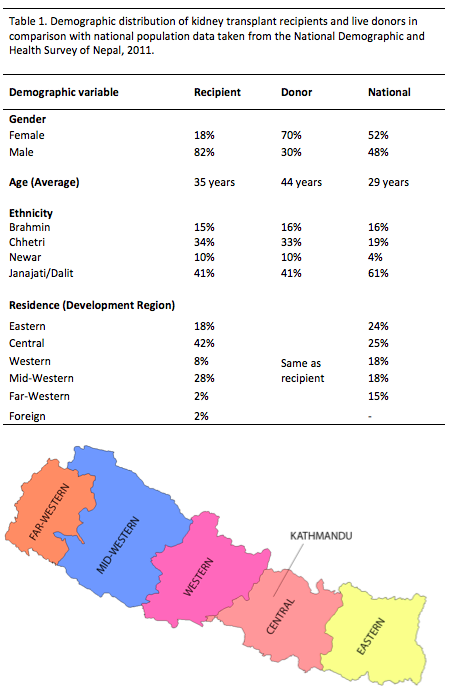Access to Living Donor Kidney Transplantation in Nepal.
1JHU, Baltimore
2Grinnell College, Grinnell
3Human Organ Transplant Center, Bhaktapur, Nepal
Meeting: 2017 American Transplant Congress
Abstract number: C51
Keywords: Kidney transplantation
Session Information
Session Name: Poster Session C: Disparity in Access and Outcomes for Solid Organ Transplantation
Session Type: Poster Session
Date: Monday, May 1, 2017
Session Time: 6:00pm-7:00pm
 Presentation Time: 6:00pm-7:00pm
Presentation Time: 6:00pm-7:00pm
Location: Hall D1
Kidney transplantation is a relatively new and rapidly growing treatment modality in Nepal. Disparities in access to care are greatly amplified in a developing country like Nepal due to social factors such as gender, ethnicity, and socioeconomic background; however, disparities in access to living donor kidney transplantation (LDKT) have not been reported since its establishment in Nepal.
METHODS: We analyzed retrospective data from one of the two active transplant centers in Nepal to assess factors that affect access to LDKT. The study population was made up of 300 kidney transplant recipients, and their live donors from 2011-2016. Demographics of donors and recipients were compared to demographics for the general population of Nepal as ascertained from the Demographic and Health Surveys (DHS).
RESULTS: Men comprised 82% of the recipients but only 30% of the donors. Members of 'lower castes' (Janajati/Dalit) made up 61% of the Nepali population but only 41% of the recipients (Table 1; p<0.001). Members of 'higher castes', Chhetri, and Newar, made up 34% and 10% of the recipients respectively, but only 19%, and 4% of the general population. By law, donors must be related to recipients. 41% of donors were parents, 32% were spouses (41 wives, 3 husbands), 19% were siblings, 4% were children, and 4% were other family members. The central region and adjoining regions were disproportionately represented among recipients (e.g. central = 25% of general population, 42% of recipients; far-west = 15% of general population, 2% of recipients; p<0.001).
CONCLUSIONS: Socially marginalized groups such as women and lower caste groups are underrepresented in the transplant cohort. Similarly, patients farther from the transplant centers, both of which are in central Nepal, are also underrepresented in the transplant cohort. The transplant community should target women and members of disadvantaged castes to expand access to living donor kidney transplantation in Nepal.
CITATION INFORMATION: Shrestha P, Rasmussen S, Thomas A, Ferguson S, Massie A, Segev D, Shrestha P. Access to Living Donor Kidney Transplantation in Nepal. Am J Transplant. 2017;17 (suppl 3).
To cite this abstract in AMA style:
Shrestha P, Rasmussen S, Thomas A, Ferguson S, Massie A, Segev D, Shrestha P. Access to Living Donor Kidney Transplantation in Nepal. [abstract]. Am J Transplant. 2017; 17 (suppl 3). https://atcmeetingabstracts.com/abstract/access-to-living-donor-kidney-transplantation-in-nepal/. Accessed December 15, 2025.« Back to 2017 American Transplant Congress
